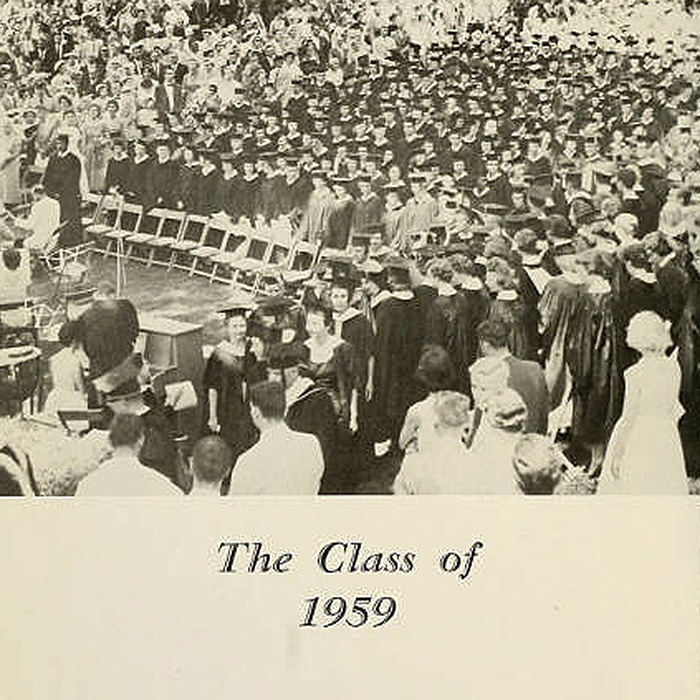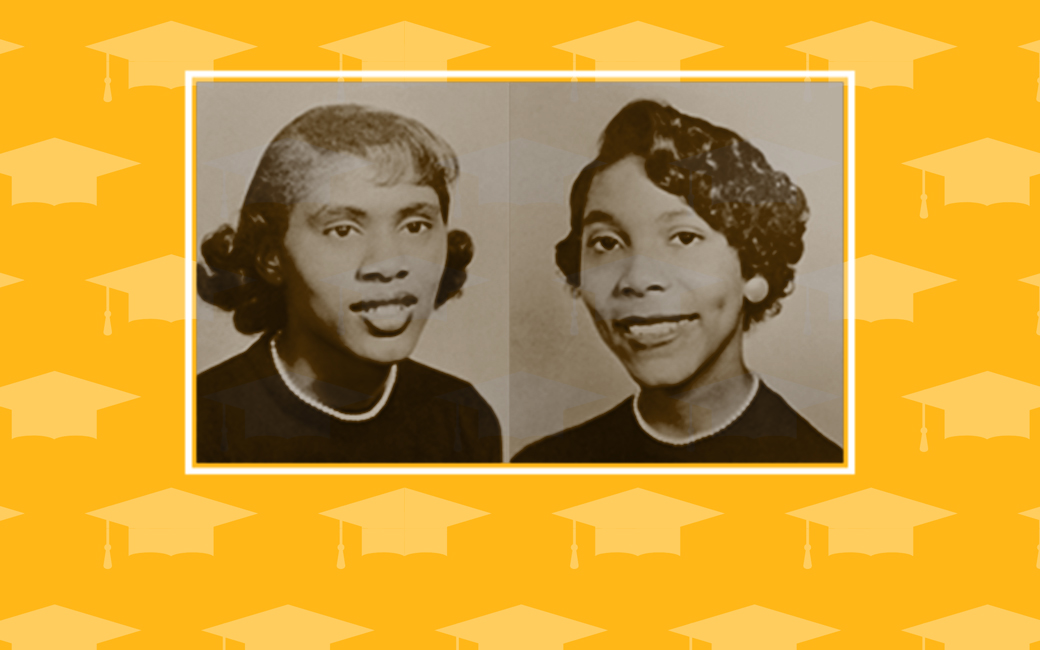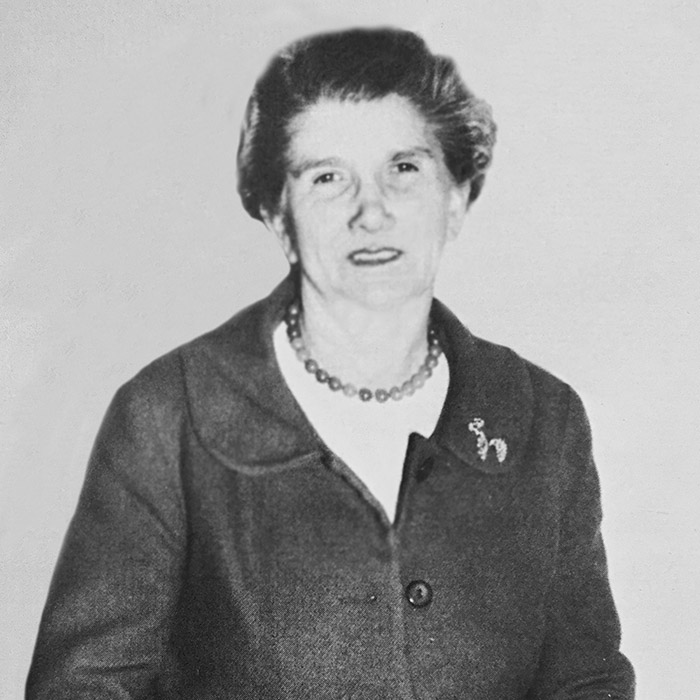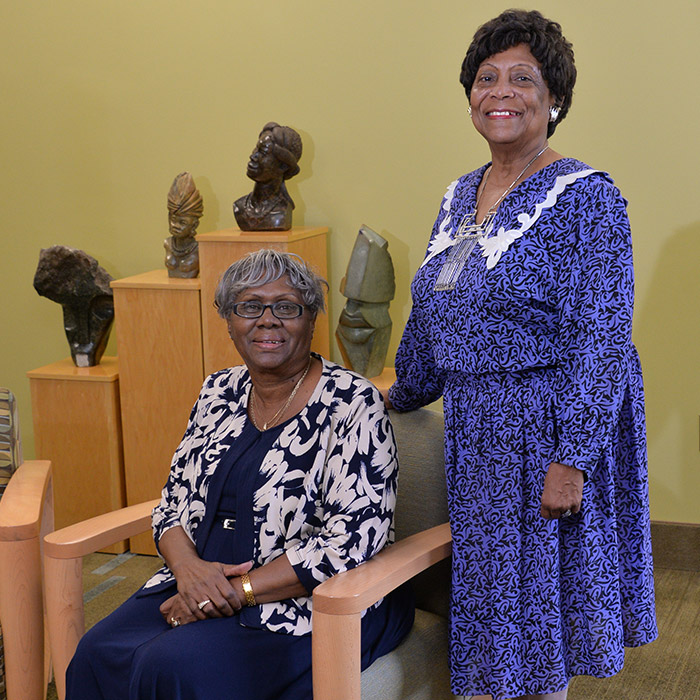
1959 Commencement Ceremonies
This photo of the 1959 Commencement Ceremonies was taken from the State Teachers College yearbook.
When a Supreme Court decision opened the door to educational opportunity, Marvis Barnes ’59 and Myra Harris ’59 stepped through to enroll at the State Teachers College at Towson. Their arrival signaled the beginning of a determined, rewarding — and at times hurtful — journey.

The decision would alter the course of millions of lives, black and white alike.
On May 17, 1954, a landmark U.S. Supreme Court case, Brown v. Board of Education, overturned state laws establishing racially segregated public education.
For more than 50 years Maryland stipulated that its black citizens attend “separate but equal” schools. They were separate, but too often unequal.
Following Brown v. Board of Education, formerly all-white public schools and colleges across the country opened to black and other nonwhite students. Some complied with the decision promptly and without incident. Others resisted, especially in the Deep South. For years afterward, violence marred attempts at racial integration.
The 1,164-student State Teachers College at Towson had already eliminated the color barrier peacefully with the admission of four Morgan State College (now Morgan State University) graduates into its one-year teaching-certificate program.
Harris and Barnes, both stellar high-school graduates with glowing recommendations, were to become the first black students to earn bachelor’s degrees from the college.
For four years they (and the pioneering black students who followed them) brought a dab of diversity to the overwhelmingly white campus.
Myra Harris, then a recent graduate of Baltimore’s Frederick Douglass High School, had already been accepted at the historically black Coppin State Teachers College (now Coppin State University).

Later she found herself at a meeting listening to Rebecca C. Tansil, director of admissions at the State Teachers College at Towson. Harris says she approached Tansil afterward to ask who could attend the college. The firmness of her response had an impact, Harris remembers. “Towson,” Tansil said, “is open to everyone.”
Harris decided to transfer. When Coppin State balked at releasing her records, the staff at Frederick Douglass High, glad to help an illustrious graduate, provided her transcripts and other records in a sealed envelope. Harris and her mother then carried the envelope to a meeting with Tansil and Orielle Murphy, dean of students, on the Towson campus.
Harris’s qualifications were never in question. After all, she’d graduated third in her high school class of 401. Tansil confirmed the young woman’s distinction as the college’s first black freshman. Then, Harris recalls, she said, “Myra, if you have problems, please don’t hesitate to call me.”
Harris had aspired to become a teacher since childhood. Now she was a “dayhop” (commuter) majoring in elementary education at the state’s largest teachers college. September 1955 marked the beginning of a college career distinguished by success both in and out of the classroom — as well as exposure to bias and bigotry.
“ The exposure to people who weren't like me was better for me than being in a segregated environment. ”
Marvis Barnes (then Marvis Brown) grew up in Turner Station, a close-knit community near Dundalk, Maryland. “It was an isolated, segregated neighborhood,” Barnes explains. As a top-notch student at the all-black Sollers Point High School, she knew Towson only as a “white school.”
“I didn’t know I could go there,” she says.
Mr. Morton knew otherwise. Barnes remembers him fondly as a “big, tall man” who taught high-school mathematics and challenged her and her classmates every day.
He was determined to see his star student enroll at the State Teachers College in Towson.
Barnes already had been admitted to two historically black colleges: Morgan State College (now Morgan State University) and Howard University. She’d been offered some scholarship money and was in the process of deciding between them when Mr. Morton interceded.
Morton told Barnes’s mother that if her daughter aimed to be a “big-time teacher,” she needed to send her to the State Teachers College at Towson.
The math teacher then obtained an application and asked Barnes’s mother to complete and mail it.
“Someone from the State Teachers College phoned my home and told me I had to take a test as part of the admission process,” Barnes remembers. “I had mixed feelings, but my mom urged me to go ahead and try. She said, ‘Be yourself and you won’t have any trouble,’ so I took the long streetcar ride to the Towson campus.”
She was met by Rebecca Tansil, who explained that Barnes would be admitted if she passed a comprehensive test.
Tansil then escorted her to a large room in Stephens Hall — Barnes thinks it was the music room — and instructed her to leave the test with the custodian when Tansil had gone for the day.
“It was not the SAT,” Barnes emphasizes. “I had already taken that.” She remembers the test as a basic assessment of reading, math and English skills.
“I finished it in a couple hours,” Barnes recalls, “and I was so afraid when I turned it in.” Evidently surprised, Tansil asked if she had finished. “Are you sure?” she persisted.
But when the director of admissions examined Barnes’s answers, her doubts evaporated. “Congratulations!” she exclaimed. “You’re admitted.”
Barnes then explained that she lived in Turner Station and would have to make a grueling streetcar commute every day. Tansil seemed to take that in stride. “Congratulations!” she repeated. “You have a room in the dorm.”
“That’s how I ended up at the State Teachers College,” says Barnes, who majored in secondary and middle school education.
“Glory to Mr. Morton.”
The photos below are from Towson University’s digital photo archive.
Myra Harris remembers getting up early every morning to catch the No. 8 streetcar. “I’d always try to sit with other students and exchange ideas,” she says. “We learned about each other that way.”
Harris says she didn’t encounter blatant racism on the Towson campus. There were no ugly taunts, racial epithets or threats, and in fact many students, faculty and staff seemed receptive to integration. But at times she found herself on the receiving end of what are now called microaggressions — subtle words or behaviors meant to let her know she was an outsider.
Harris endured the slights and kept on going. “I’d pray over it,” she says.
Sometimes the rejection wasn’t so subtle.
For example, during her freshman year Harris was assigned to observe classes in a Baltimore City elementary school. “When the teacher there found out I was black, she had an excuse,” Harris recalls. “She said she was ‘not ready to accept me at that time.’”
One professor continually doled out A’s to white students while making Harris — who thought her work equaled theirs — make do with A minuses. “I asked what I could do to raise my grade, but never got much of an answer,” she says. “Even the other students noticed that their grades were always higher than mine.”
She decided not to make an issue of the biased grading.
Once some of her classmates shunned her. “When the professor asked us to break into groups, it was clear that some students didn’t want to be with me,” Harris recalls. She says Orielle Murphy resolved the problem by forming the groups herself. “She assigned those same students to sit with me,” says Harris with satisfaction. “She wanted us to get to know each other.”
When the time arrived for student teaching, the college assigned Harris to a nearby elementary school. But she subsequently learned that it, too, was “unready for integration.” “I was very disappointed,” she recalls.
Instead she did her student teaching on campus at the Lida Lee Tall School, a site ordinarily limited to resident students.
Although her student-teaching supervisor seemed cordial, at times her actions suggested darker motives. “We were required to keep a log book,” Harris says. “The supervisor collected the books every week, graded them and returned them to us.”
“One week as she returned my partner’s book, she said, ‘Myra, I don’t have your book.’ She kept forgetting to return it. I knew that if I didn’t keep a log, I’d get behind. I was not going to get behind, so I started a second book.”
Then one day the supervisor approached her with a plan. “I’m going to take you home with me,” she insisted. “That way I’ll see the book and return it to you.”
Harris asked the supervisor if she would take her home afterward, and the supervisor agreed. After phoning her mother to say she’d be late, Harris accompanied the woman to her house in a suburb north of Towson.
“She gave me a room-by-room tour, which I thought was unnecessary,” Harris says. “When we got to the bedroom, she said, ‘Myra, here’s your book!’”
Then she drove her student back to Baltimore.
As they pulled up to the curb, Harris says the supervisor exclaimed, “Oh, Myra, you live in a beautiful house.”
The woman’s stratagem didn’t fool Harris for a minute. “I think she just wanted to see where I lived,” she says. “But I did get a good grade in student-teaching.”
Harris emphasizes that good came of the hurtful experiences. “They made me a strong person,” she says.
As an upperclassman, she became a member of the college’s Freshman Advisory Council. By then there were a few more black students, and she enjoyed sharing the insights she’d gleaned. She coached these young men and women on how to keep moving forward despite occasional setbacks, saying, “You can’t worry about everything. Deal with it and put it behind you.” Later they’d tell her how much they appreciated the advice.
Resident student Marvis Barnes says the top floor of Richmond Hall became her home away from home.
“I had a handpicked roommate, a junior named Katherine “Kathy” Smith, who was the nicest person on earth,” Barnes says. “There were eight other girls on the floor, and they were so accepting that we bonded right away. We were close, like sisters.”
Her new roommate shared her deep religious faith. “We had Bible study and devotions every night before we went to sleep,” she recalls.
“Our group eventually moved to Newell Hall, and we lived together until we all graduated. It was a delightful experience.”
“ There were eight other girls on the floor, and they were so accepting that we bonded right away. We were close, like sisters. ”
Although Barnes’s friends had her interests at heart, she says a couple of faculty members did not. “They would go down the row asking questions,” she says. “When it was my turn, they’d skip over me.”
Not one to be ignored, Barnes answered anyway.
There were times when her mere presence excited unwanted attention. “My friends and I used to walk up to Hutzler’s [department store] after dinner,” she says. “White people driving past on York Road would actually slow down to look at us.”
She was a young black woman clearly on equal terms with her white classmates, and their easy comradery turned heads wherever they went.
Today Barnes shrugs off those disquieting moments. “They were little things,” she insists.
“My friends were protective and Dr. Tansil and Orielle Murphy always asked me how I was doing.”
Barnes says student-teaching was a rewarding experience for her, most likely because the college had scouted local schools to identify which ones would welcome her. Every day she rode a campus bus to and from a Baltimore County middle school. There she says she worked with “a fantastic teacher who taught me a lot.”
Still, neither Barnes nor Harris took chances with their personal safety.
“I never feared for my life,” Barnes explains, “but I never went anywhere alone. I took precautions.”
Harris recalls having to leave campus after dark, something she’d always managed to avoid. As she waited alone at the York Road streetcar stop, a carful of unruly men sped by. “They were yelling at me,” she remembers. “I was frightened. Thank the Lord the streetcar came right away.”
After earning their bachelor’s degrees in 1959, both women went on to illustrious careers, initially as classroom teachers and later in administrative roles.
Myra Harris taught elementary school and supervised student teachers. She served as assistant principal and later principal at Harlem Park Elementary as well as at Madison Square Elementary in Baltimore City.
She earned a master’s degree from Columbia University and took postgraduate courses at Johns Hopkins and Loyola universities.
The local Jaycees chapter recognized her contributions with Outstanding Elementary School Principal and Outstanding Educator of the Year awards. In retirement, she continues to be involved in her church, saying her work there helps to keep her mind focused.
In retrospect, Harris doesn’t hesitate to credit the State Teachers College for her professional achievements. “The exposure to people who weren’t like me was better for me than being in a segregated environment,” she explains. “Towson was a treasured experience that helped to make me who I am. I would do it again.”
Marvis Barnes began by teaching core social studies and English at Garrison Middle School, where she found innovative ways to encourage boys to read. (She made them buy and read a newspaper every weekend.)
She married a Morgan State graduate, reared two sons and earned a master’s degree from what is now Loyola University Maryland.
At Northwestern Senior High School she served as department chair and assistant to the principal. “After I retired, the principal phoned and asked me to come back.” She relented and returned to Northwestern for another four years. “I loved every day of it, but after 54 years I needed to learn how to rest,” she admits.
Now retired, she remains active in her church and loves spending time with her four grandchildren. Today she recalls her undergraduate years as a wonderful, formative experience. “Towson made me a teacher,” she says.
Myra Harris and Marvis Barnes made TU history, though they didn’t recognize that at the outset. The two women integrated the State Teachers College only three months before Rosa Parks refused to surrender her seat to a white passenger on a Montgomery, Alabama, bus. By the time they graduated, the Civil Rights Movement was in full swing under the leadership of Martin Luther King Jr.

And make no mistake: Harris and Barnes are proud alumnae who excelled academically, socially and professionally. Both say the State Teachers College at Towson provided an excellent foundation for long and rewarding careers. They remain grateful to Rebecca Tansil and Orielle Murphy for their unstinting guidance and encouragement. And although they agree that although most members of the campus community were receptive to integration, some were not. That, they agree, was an unfortunate fact of life.
Harris and Barnes dealt with it, finding solace in friends, family and faith. They pressed on, eyes on the prize, with the support of those who wanted them to succeed.
And they did.
Jan Lucas is associate director of publications in University Marketing and Communications.
When Marvis Barnes and Myra Harris enrolled at the State Teachers College at Towson, financing their education wasn’t a concern. In those days the state waived tuition for students who pledged to teach in Maryland’s public schools for two years after graduating. Barnes and Harris repaid the favor many times over during their long and illustrious careers.
Decades of cuts in state support for public colleges and universities have left many students struggling with debt. The Barnes-Harris Scholarship, founded more than 20 years ago to honor TU’s first black graduates, helps these young men and women at the outset of their TU careers.
The Barnes-Harris Scholarship is awarded annually to an incoming freshman who possesses “a strong allegiance to the African-American culture.” Recipients must be graduates of a metropolitan public high school, enrolled full-time (12 or more hours) and with demonstrated financial need. All applicants must submit an essay of no less than one page, double-spaced.
Make a gift to the Barnes-Harris Scholarship.